Did you know that every 10th of July it’s unofficially Teddy Bears Picnic Day in some countries? It originated from a very old children’s song by the same name. On this day, children can either prepare a picnic to share with their teddy bears (as the photo shows) in their own homes (a tea party for them, of sorts) or can go to a park with their families, a picnic and their teddy bears. There, they will see many other families, with their favourite teddy bears, having a picnic as well. It is a fun thing for children, and for families if they want to partake in the fun.
Luckily, you don’t have to wait until July 10th to partake on the fun. Any day of the week, you can invite your child’s teddy bears for a picnic, to the delight of your child. You can have a regular picnic, either at home like I describe in this activity, and then a mini picnic right next to the family picnic, just for the teddy bears, or your child can just prepare a picnic for their teddy bears on their own – both are fun!
Best Ages for This Activity
2 to 5, although older children may like it too!
How to Prepare
What You Will Need Just for the Teddy Bears:
- A mini picnic basket (you don’t need one really, but your child can use it for pretend-play many times over if they like it. You can of course use whatever you have at home, just choose miniature plates and cups – even espresso cups – and cutlery)
- A towel or baby blanket to use as a picnic blanket
- Tiny sandwiches and food (see below for some ideas); or
- Play food like this, or this
- Your child’s favourite teddy bears
What To Do
- If you are going on a family picnic, prepare the food as I describe in this activity. In addition, here is what you could do for the teddy bears, for this part, enlist your child’s help in preparing the picnic for them:
- Cut the sandwiches into extra tiny pieces for the bears. A great activity in and of itself is to teach your child how to make sandwiches and let them prepare the meal. This will teach them independence, science, cooking skills, fine motor skills and many other skills. You can use cookie cutters of various sizes and shapes to further fine motor skills and math (talk about the different sizes and shapes, measure, etc.)
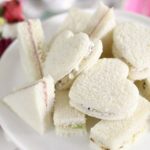
-
- Put some of the tea your child can prepare into a small teapot that your child can serve to the teddy bears (you can add more milk or water, so it is not too hot)
- Cut the fruit into even tinier pieces for the teddy bears
- Add tiny cookies or bake tiny pancakes with your child (you can even put icing on them to make them look more like dessert). Icing is fun because your child can make different colours by adding food colouring to it (separate white icing into different small cups and add in one drop of food colouring) and add sprinkles or decorations. Plus, it is all edible in case your child partakes in the picnic
- Help your child set up the picnic area for the teddy bears, either next to your own picnic, or by itself if you are not partaking in the fun. If it can be outside, even better!
Learning Opportunities
This activity is great for your child’s imagination, as they pretend play (part of our dramatic play curriculum at our CEFA Early Learning schools). It is important that your child prepare the picnic, not you (but you can help, which is a great way to spend quality time with your child). By doing so, they learn self-help skills, they learn to cook, and even better, they learn to contribute, because they are doing something for someone else (their teddies). If they play outside, it is a great way for your child to connect with nature. It is a great activity to play with a sibling or friend (which builds social skills) or by themselves (which helps with focus, imagination and attention span) all of which are good social and emotional Cooking for the teddy bears encourages your child to be independent, learn to cook and think of others. It teaches S.T.E.M., especially math, and science, and fine motor skills, which leads to writing.
Ideas to Inspire You
This play food is made with sponges:
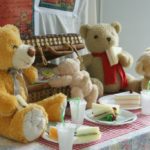
This is if you were hosting a teddy bear picnic for friends (when we all can go out again) I found some really neat ideas that you could even use for a birthday party theme:

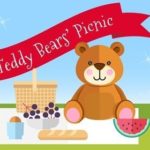
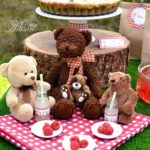
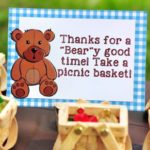
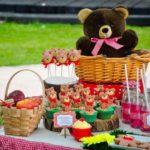
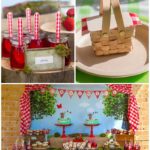
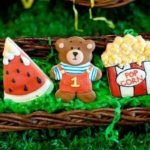
This shows you how simple a teddy bear picnic can be:
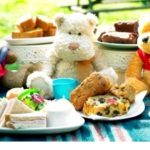
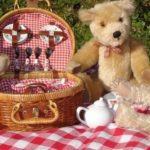
Extended Learning Opportunities
- Your child can read a story to their teddy bears. This will improve your child’s reading and literacy
- Teach them a nice poem about teddy bears, like this one, which they can recite and even act out before they go to bed:
Teddy bear, teddy bear, turn around,
Teddy bear, teddy bear, touch the ground,
Teddy bear, teddy bear, reach up high,
Teddy bear, teddy bear, touch the sky,
Teddy bear, teddy bear, bend down low,
Teddy bear, teddy bear, touch your toes,
Teddy bear, teddy bear, go to bed,
Teddy bear, teddy bear, rest your head,
Teddy bear, teddy bear, turn out the lights,
Teddy bear, teddy bear, say “good night”.
- Your child can make invitations for the teddy bears, and even put them in envelopes for them. This will improve your child’s writing, reading and literacy skills. You ask your child what they should write on the invitation, so people know where to go, when to go, etc. The more your child thinks about it, the more they are using their problem-solving skills, essential in life, and a huge part of our S.T.E.M. curriculum. You can also make a poster and use watercolours or a collage, to add visual arts. Here are some examples I found out there for your inspiration (of course, only take what you need from it – no need for a magic show):
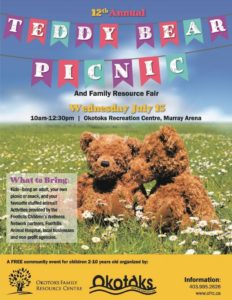
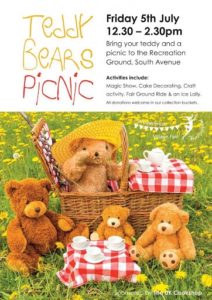
- Plan the picnic with your child. Ask them questions such as:
- What would you need?
- What date would be best?
- Which teddy bears would they like to invite?
- Should you make invitations?
- What should you cook together?
- Would they like tea or lemonade?
- Encourage your child to make a list of what you both will do. Even if your child does not write, they can still make a list by illustrating those words (for example, they can draw a sandwich instead of writing “sandwiches”). Once they draw it, write the name (sandwich) beside it so they begin to connect that everything has a name that you can learn to write. It also helps them form the notion that there is one word for each one thing. Making the list is an incredibly rich pre-writing
- Take the time to connect with your child, ask them questions like the ones below. This opportunity to chat, share ideas, dream together, plan together, share stories, laugh and feel pure joy will help you bond with your child and form an even deeper connection. Here are some ideas to get you started:
- What are some of the things they like about picnics?
- What are their favourite memories about picnics with you or with friends?
- Do they have a favourite teddy bear? Which one? Why is that the favourite? Since when?
- Tell them about your favourite teddy bears over the years
- Ask them which teddy bears they would take if they could only take three, and why? How would they decide? How would it be different?
- Plan a similar picnic for other toys, like dolls, or stuffed animals that are not teddy bears, lego people, playmobil, anything you can imagine. Think of what would need to change (for example, if the teddy bear food is much smaller than the food you eat, how small should they make the food for the lego people?)
- Make a teddy bear cake for the whole family! This is a great S.T.E.M. activity, involving math, science and engineering. If you are not a great baker, just use a pre-mixed box of cake mix which can also be used for baking cupcakes. Below is a rough idea of what the process is like, but you can do it however you like. Figuring out how to make a teddy bear out of all those cake and cupcake pieces is in itself its own engineering activity, so enjoy the process knowing your child is learning so much.
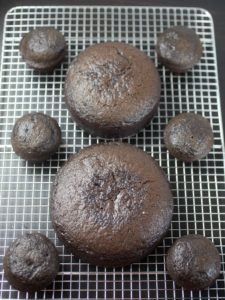
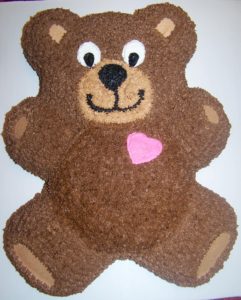
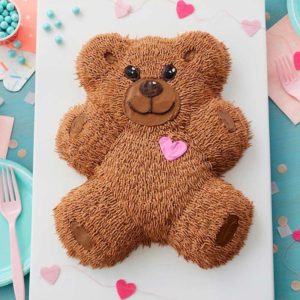
- You can teach your child the song “Teddy Bear Picnic”! If you play the guitar, even better!
Your child can make headbands or crowns with teddy bear ears to wear, which works on their colouring skills, scissor skills, fine motor skills – all skills essential for writing, as well as for school. It of course extends pretend play (dramatic arts). Here are some examples:
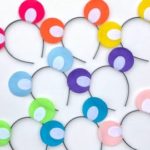
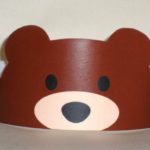
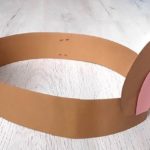
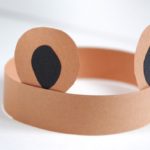
- Your child can even dress up as a bear using an old halloween costume or just brown clothes and felt ears for extended dramatic play opportunities:


- Extend the play after the Teddy Bear Picnic by setting up a plate at your dinner table for your child’s favourite teddy (much to their delight and surprise), with small plates, cups and cutlery. Children love surprises, they love miniature things (plates, cups, food) and it creates an opportunity for you to be in the moment with your child (and the bear). You can then ask your child (or the bear) what they like to eat, and get to know the new guest: Where did the bear come from (a friend, a cousin, a birthday present, a store)? What is the bear’s favourite thing about your child? Take your time, let them expand on their answers. This too is a great idea for bonding and dramtic play.
- Learn about real bears – try this activity
- Learn how to draw a teddy bear (or several) with your child. You can also paint one as an additional activity. I prepared a document you can access here, with different styles of drawing (including some classics) where you and your child can discuss the different styles they like, the details, the paintings versus drawings, and so much more. This will enrich your child’s vocabulary while learning about drawing and illustrators. This exercise is an immense opportunity to discuss, elaborate, exchange ideas, thus enriching your child’s vocabulary and making the bond between you even stronger. As your child is drawing, name the body parts for additional vocabulary. Drawing is excellent as a precursor for writing as well as for visual arts and math.
- Make a book of bears with your child: use a beautiful but inexpensive notebook with blank like this one. There, help your child write the title (or write it for them if they are too young), draw a photo and write their names as authors of the book (ex: Bears by John Smith). Inside, you can paste photos of bears cut out from magazines (I prepared a document you can access here with some photos I found myself that you can print and cut out). Once the book is done, display it proudly in your child’s library.
- Make a teddy bear together using fabric or felt and glue or thread. Here are some ideas for inspiration:
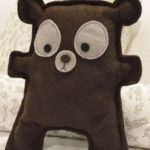
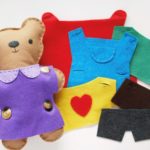
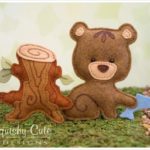
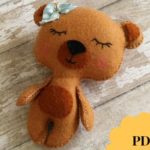
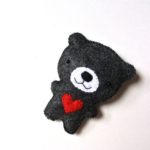
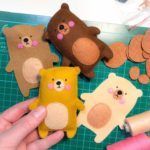
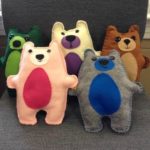
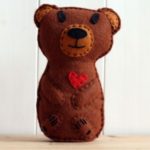
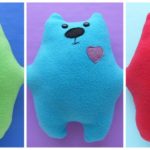
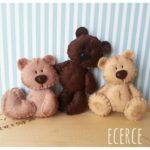
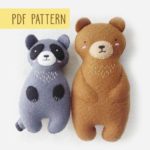
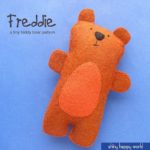
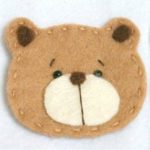
- Make teddy bear puppets or finger puppets out of felt for dramatic play. Your child can draw or paint a forest background for their “play”. Here are some ideas.
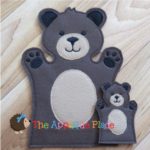

If you are not confident in your puppet-making abilities, here are some I would recommend, but again, you can literally stick a picture of a teddy bear or bear to a popsicle stick and have a puppet that will offer the same quality of play as a purchased one. You can even take a photo of your child’s favourite teddy against a white background, print them and use them as puppets. Nevertheless, here are some links:
- Make a paper teddy bear. Sewing (with a big play needle like this one) and yarn. You can keep it even more simple by just offering it as a lacing activity:
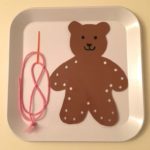
- Help your child sew, knot or knit a blanket for your favourite teddy bear. You can teach your child to weave. This is a great quiet activity that will entertain your child for days! They can also just cut any old piece of fabric to make one. It can be a little bigger than this one:
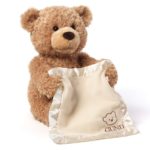
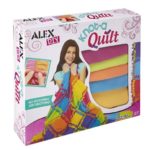
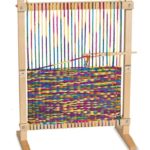
- Together, make an outfit for your teddy bear (an old sock can be cut, and your child draws on it using fabric markers) it can be very simple, like this one:
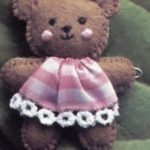
- Your child could make a bed for their favourite teddy bear. This is very good way to put your child’s S.T.E.M., engineering and math skills to practice. Encourage them to figure out how to make a solid bed using wood, cardboard, Styrofoam, or any other material you have around the house. You can also help your child cut an old sheet to make sheets and a pillow, and even a blanket.
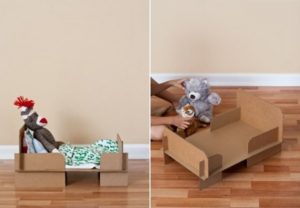
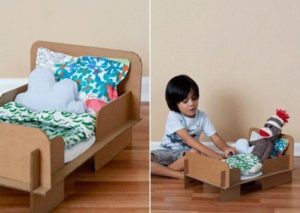
- Celebrate teddy bear’s birthday by making them a birthday (cup)cake! Together, find a day in the calendar to make it your child’s teddy bear’s birthday. You can celebrate it every year after that, which your child will love. This is a wonderful way to study time measurement, learn how to read a calendar and also plan ahead! Aside from the cupcake baking and/or decorating (great for fine motor skills, which are essential for writing, as well as life skills, fostering of independence, focusing skills and science) you can also help your child make invitations for the party, write a card or letter to their teddy bear (all literacy activities), decorate the house or their room for the party, blow balloons and have a magical day! A great dramatic play activity
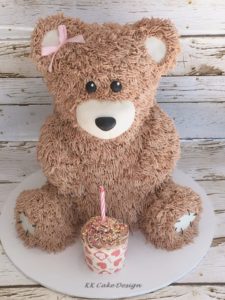
- Make a teddy bear paper puppet
- Make a teddy bear felt story for your child dramatic play
- Math: teddy bear patterning games
Books You Might Like
Toys and Other Things You Might Like